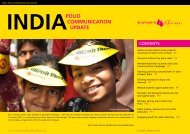Independent Monitoring Board - Global Polio Eradication Initiative
Independent Monitoring Board - Global Polio Eradication Initiative
Independent Monitoring Board - Global Polio Eradication Initiative
- No tags were found...
You also want an ePaper? Increase the reach of your titles
YUMPU automatically turns print PDFs into web optimized ePapers that Google loves.
AT A GLANCESANCTUARY BY SANCTUARYThe challenge of stopping polio transmission globally is concentrated not only in asmall number of countries, but in specific parts of these countries. Our previousreport termed these ‘sanctuaries’ for the polio virus, places in which it has takensafe refuge.There is no mystery about why the virus is safe in these sanctuaries. In onevaccination campaign after another, too many children are being missed. Stoppingtransmission therefore requires a razor-sharp focus on reaching these missedchildren; on vaccinating more children with the next round than were vaccinated withthe last. Without this focus, the Programme is simply an expensive way to vaccinatesome children many times, whilst missing other children over and over again.Programme data from the six countries with persistent transmission suggest thatthere are 2.7 million children aged under five years who have never received evena single dose of polio vaccine (figure 6). The much larger number who receive adangerously low number of doses is not easy to discern from programme statistics.Even within small areas, the missed children may belong disproportionately tominority population groups. Not all of these are in the sanctuaries. But if a datadriven,missed-children-focused approach can be honed in the sanctuaries, it can beapplied elsewhere also.Our previous reports have examined the Programme country by country. Inthis report, we look sanctuary by sanctuary. Many of the challenges in the poliosanctuaries fall into the same general categories (poor programme management,low community demand). But if we drill down and examine the situation in detail,we find that in no two sanctuaries are the challenges the same. As we examineeach sanctuary, we take a particular interest in the precision with which the reasonsfor missed children are understood, solutions described, and impact tracked.Imprecise descriptions of ‘poor quality’, ‘management issues’ and ‘refusals’ saylittle about what the problem is, and therefore about what solution is required.A sharp focus on missed children, insight-rich data, and precise plans representthe strongest possible force to expel the virus that is sheltering in each of thesesanctuaries, and therefore to secure global polio eradication.We focus on the sanctuaries for two reasons. First, they are the areas that demandgreatest focus. Second, we consider the Programme’s actions in them to be awindow onto the country programme as a whole. If a country can get to grips withits areas of most intense challenge, it is in a strong position to stop transmissionelsewhere as well.Sanctuaries for the polio virusplacesin which it has takensafe refugeSanctuaries only exist becausetoo many children are missedon vaccination daySome children are missedentirely – 2.7 million childrenhave never received even asingle dose of vaccine; evenmore receive a dangerouslylow number of dosesThe challenges in eachsanctuary are unique, but theapproach needs to be the same- pinpointing and pursuingthe reasons why children aremissedIf a country can get astrong grip on its toughestsanctuaries, it can do soanywhere24<strong>Independent</strong> <strong>Monitoring</strong> <strong>Board</strong> of the <strong>Global</strong> <strong>Polio</strong> <strong>Eradication</strong> <strong>Initiative</strong> Every Missed Child




